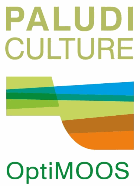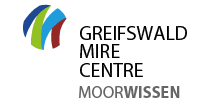OptiMOOS
Joint research project „Optimising Sphagnum farming: water management, climate impact, biodiversity & product development“

Joint research project „Optimising Sphagnum farming: water management, climate impact, biodiversity & product development“
Sphagnum farming is feasible as the 14 hectare site in the peatland Hankhauser Moor (county Ammerland in the federal state Lower Saxony) with high biomass yields shows. At the same time, the improvement of ecosystem services has been demonstrated: significant reduction of greenhouse gas emissions compared to the drainage-based previous use, water and nutrient retention and local cooling have been achieved, and the Sphagnum farming sites represent a valuable habitat for rare, bog-typical species. The Sphagnum farming site was established as part of the previous projects MOOSGRÜN and MOOSWEIT and will be continued and expanded in OptiMOOS.
Although the biomass growth of the peat mosses is very high, other than the target peat mosses species were promoted due to nutrient-rich conditions. Therefore, strategies for nutrient reduction in the water used for irrigation of Sphagnum farming sites are being developed in the joint project and tested in glasshouse and field trials. For this, also other paludiculture crops (e.g. cattail, reed), but growing under nutrient rich conditions, will be used. Additional potentials for reducing the climatic impact of Sphagnum farming sites are the reduction of topsoil removal during site preparation and the proportion of ditches, as most greenhouse gases are emitted from the ditches. As a result of the joint project, both nutrient discharges to surface waters (by increasing nutrient retention and removal) and greenhouse gas emissions are further reduced by a Sphagnum farming site. At the same time, the long-term effects of establishment, growth and regeneration of a peat moss lawn on the existing Sphagnum farming sites will be further investigated, also with regard to biodiversity (flora, fauna) and economy. In addition to the implementation of Sphagnum farming, it is planned to develop a substrate consisting of biomass from paludiculture plants.
Contents
Like MOOSGRÜN and MOOSWEIT also the joint research project OptiMOOS will feature detailed accompanying research at the study area with the following working research focus:
- Water purification: Field trials with installation of planted water basins and use of the filtered water for irrigating the Sphagnum production fields (investigation of vegetation development, hydrology, water quality) as well as climatic chamber and glasshouse trials on the nutrient tolerance of different Sphagnum species
- Minimisation of topsoil removal: Field trials with different depths of the topsoil removal and subsequent establishment of a Sphagnum production field
- Minimisation of ditches: Field trials with Sphagnum production fields with different irrigation systems (temporary ditches at 10 m intervals, ditch interval > 10 m, subsoil irrigation)
- Development of a ‘paludi-substrate’: Determination of horticultural suitability of cattail and reed; development of a substrate based on paludiculture plants including peat moss (LVG)
- Vegetation development: Investigation of water basins and Sphagnum production fields, decomposition experiments in a growing peat moss lawn (UG)
- Water quality: Nutrient balance for water basins and Sphagnum production fields (UG, contract)
- Hydrology: Water balance for water basins and Sphagnum production fields (UG, contract)
- Greenhouse gases: Determination of the greenhouse gas fluxes in the water basins as well as in the Sphagnum production fields with different topsoil removal depths and irrigation systems (UR)
- Biodiversity: Investigation of the flora as well as dragonfly and spider fauna in the water basins and in a Sphagnum farming site in their long-term succession including fungi (UG, UO, contract)
- Economy: Recording of costs and time required for planting, management and harvesting of water basins and Sphagnum farming sites
Joint network partners
- University of Greifswald, Institute of Botany and Landscape ecology (Uni Greifswald),
Department Peatland studies and Paleoecology, Partner in the Greifswald Mire Centrum - University of Rostock (UR)
- Carl-von-Ossietzky-University Oldenburg (UO)
- Research Institute for horticulture Hannover-Ahlem (LVG)
Publications
Lüdtke, M. (2021) Projekt OptiMOOS: Literaturstudie Die Nutzung von Rohrkolben und Schilf als Substratausgangsstoff
Lüdtke, M., Emmel, M. & Beßler, B. (2022) Projekt OptiMOOS: Wachstum von Saintpaulia ionantha in torffreien Paludikultur-Substraten aus Rohrkolben, Schilf und Torfmoos
Lüdtke, M., Emmel, M. & Beßler, B. (2022) Projekt OptiMOOS: Wachstum von Calibrachoa in torffreien Paludikultur- Substraten aus Rohrkolben, Schilf und Torfmoos
Lüdtke, M., Emmel, M. & Beßler, B. (2022) Projekt OptiMOOS: Wachstum von Pelargonium zonale in torffreien Paludikultur-Substraten aus Rohrkolben, Schilf und Torfmoos
Lüdtke, M., Emmel, M. & Beßler, B. (2022) Projekt OptiMOOS: Substratentwicklung im Projekt OptiMOOS










